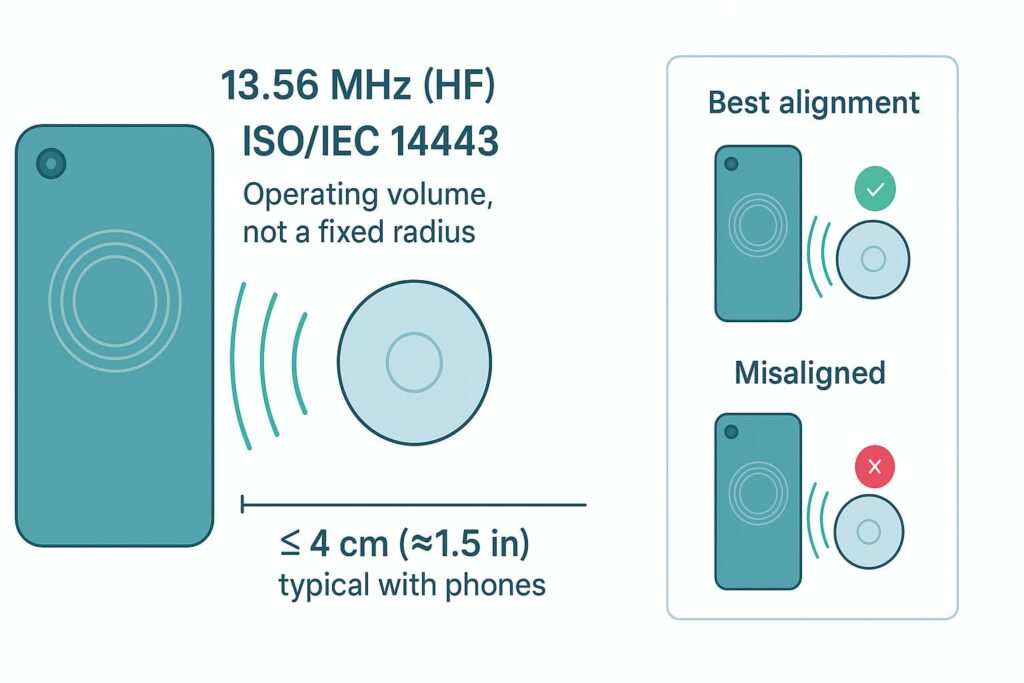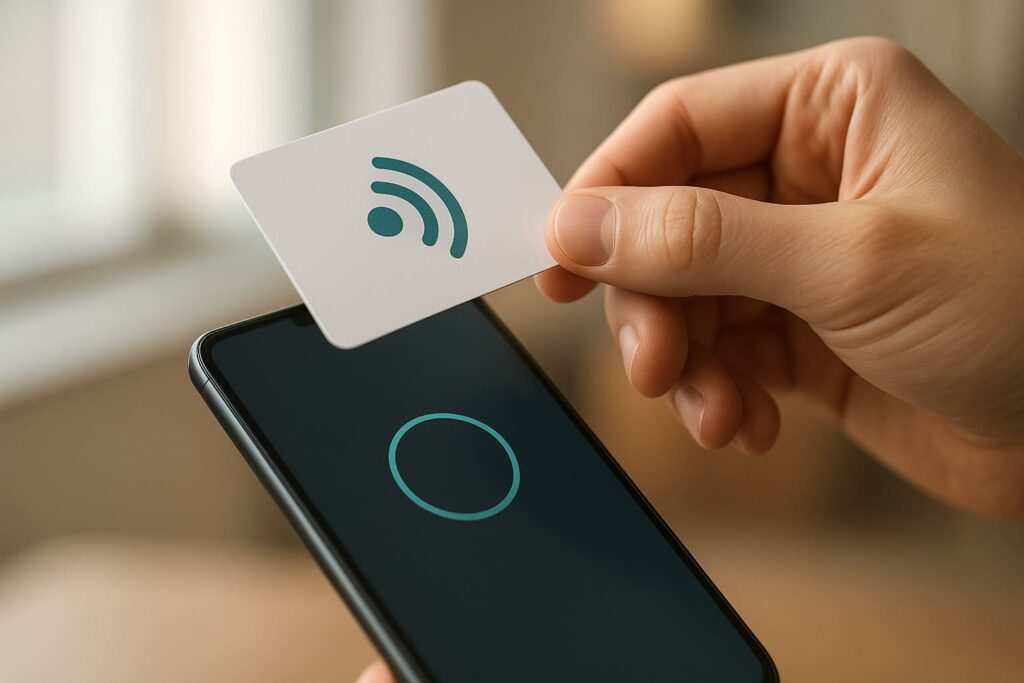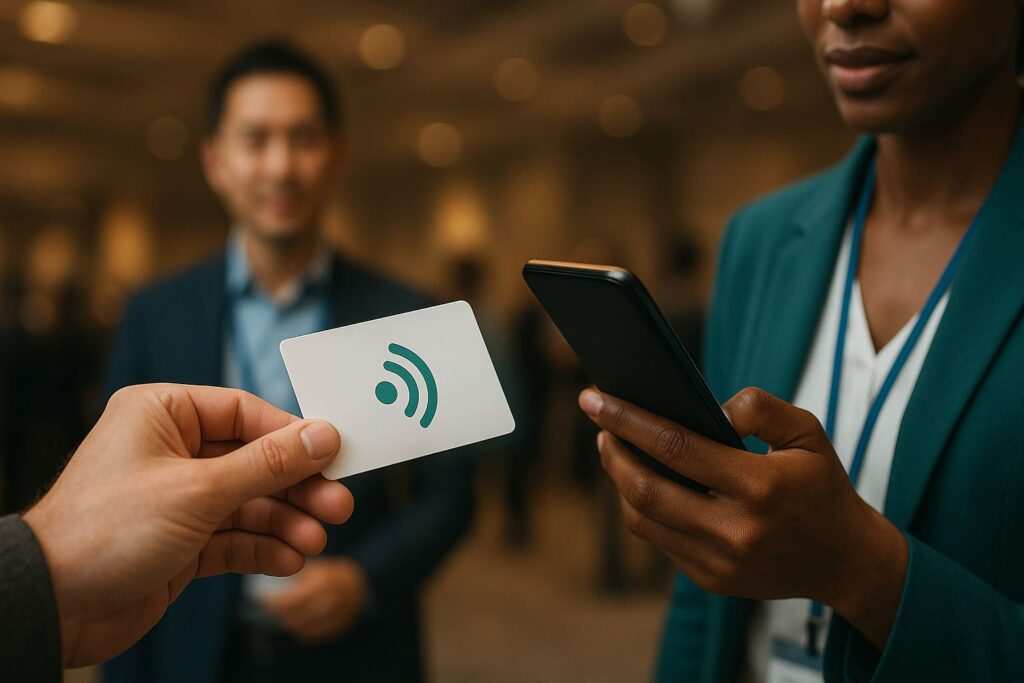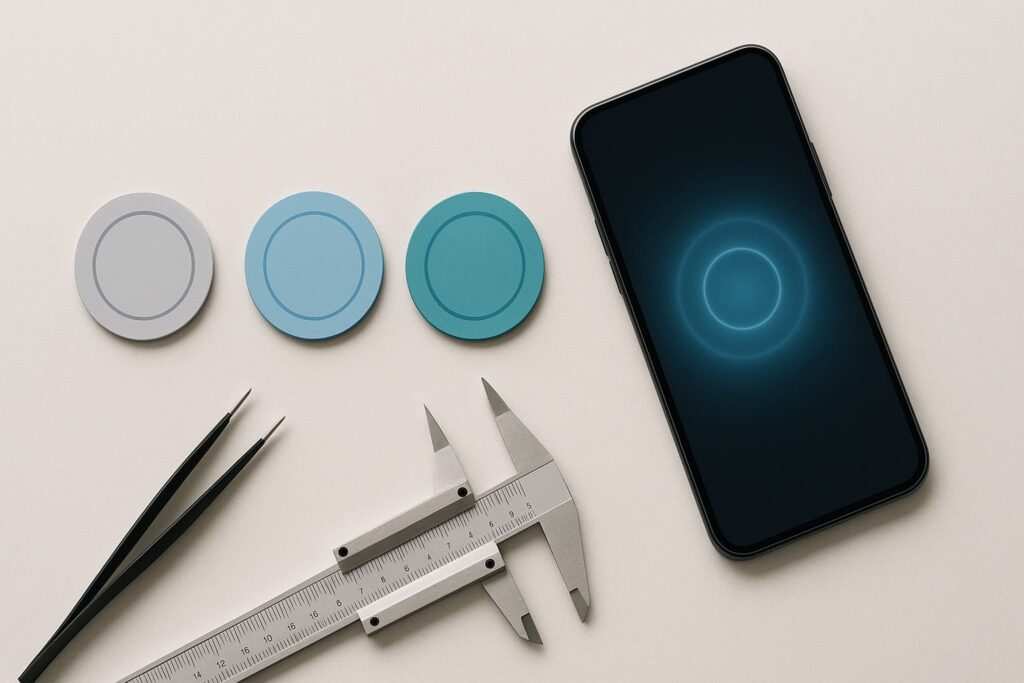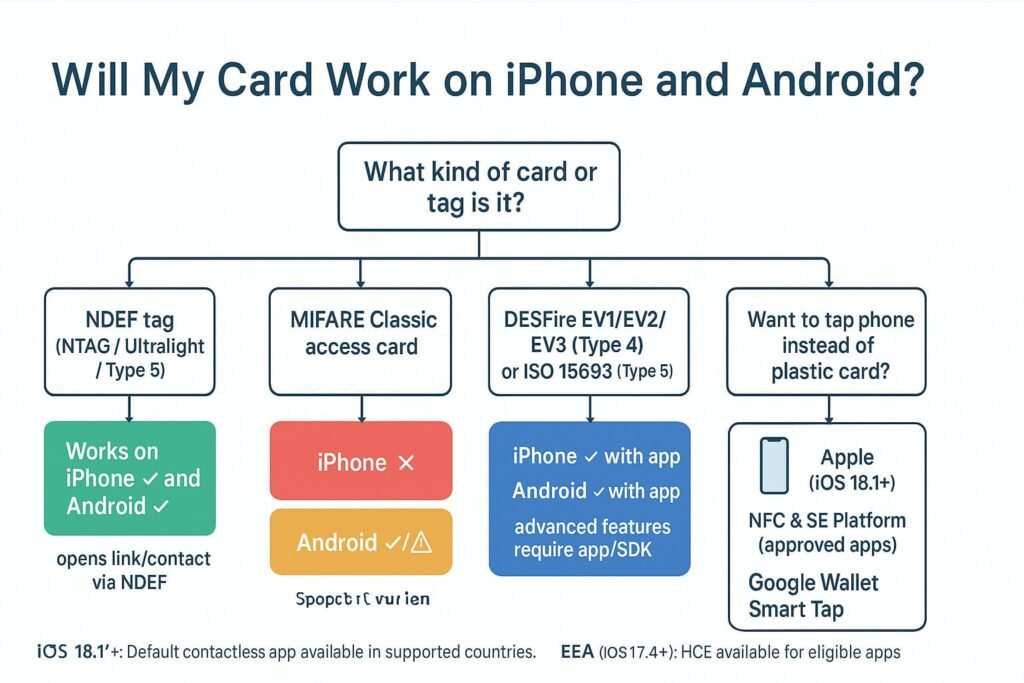Near Field Communication (NFC) is the magic behind tapping your phone to pay, but many people wonder how far can an NFC card be read and how far do NFC tags work? The simple answer is very close. The typical NFC tag range is less than two inches. However, the exact NFC tag reading distance depends on several factors, including the type of tag, the power of the reader, and even the angle of your tap. This guide, grounded in specifications for Android (NFC) and other platforms, provides a deep dive into the typical NFC range, what blocks it, how you can increase NFC range, and how its short distance is actually its greatest strength.
At a Glance: Key Facts About NFC Range
- Operating Frequency: All NFC devices use 13.56 MHz (HF band).
- Typical Tap Range: For smartphones, the range is typically 4 cm (≈1.5 in) or less (Source: Android Developers).
- Interference is Common: Metal surfaces, water, and even some phone cases can block or reduce NFC signals.
- Longer Range Is Possible: NFC Type 5 (ISO 15693) with dedicated readers can reach roughly 1–2 meters; phones remain short‑range.
- 2025 Update: NFC Release 15 increases the certified baseline operating range to 2 cm; public certification expected Fall 2025 (Source: NFC Forum).
- How to Extend Range: Using larger tag antennas and ensuring proper alignment are the easiest ways to get a more reliable connection.
What Is the Typical NFC Tag Range and Reading Distance?
For most everyday uses, like making a payment or tapping a smart poster, the NFC tap range is intentionally short. This is a crucial security feature to prevent accidental scans. According to Android Developers documentation, NFC is a technology “typically requiring a distance of 4 cm or less to initiate a connection.” This is by design for proximity interactions based on the ISO/IEC 14443 A/B standards. This is because NFC relies on a principle called magnetic inductive coupling, where one device’s antenna powers the other wirelessly, but only when they are extremely close.
Factors That Influence ‘Tap’ Range
The effective range of an NFC interaction is a delicate dance between the reader and the tag. Here are the main factors at play:
- Reader’s Antenna Power & Size: The NFC reader in your phone has a small, low-power antenna to conserve battery life. Larger phones may have slightly larger antennas, offering marginally better performance, but all are designed for close-range use.
- Tag’s Antenna Size & Quality: This is one of the biggest variables. An NFC tag has no battery; it’s powered wirelessly by the reader’s magnetic field. A larger antenna on the tag can “catch” more of this energy, allowing it to be read from slightly farther away and at more forgiving angles.
- Environment and Obstructions: Materials like metal and even water can dramatically reduce performance.
Here’s what you can generally expect in a real-world setting:
| Tag Type & Placement | Typical Read Range |
|---|---|
| Tiny NFC tag on metal with ferrite | contact to ~1 cm |
| Standard 38 mm tag on wood/plastic | ~1–4 cm |
| Large NFC card/label | ~2–5 cm |
This very short range is perfect for quick taps with a phone, but the story changes when we introduce more powerful hardware. Let’s explore the absolute maximum distance possible with specialized equipment.
What is the Maximum NFC Reader Range and Distance?
While your phone is a capable NFC reader, it’s a very different beast from a dedicated, high-power reader designed for industrial or commercial use.
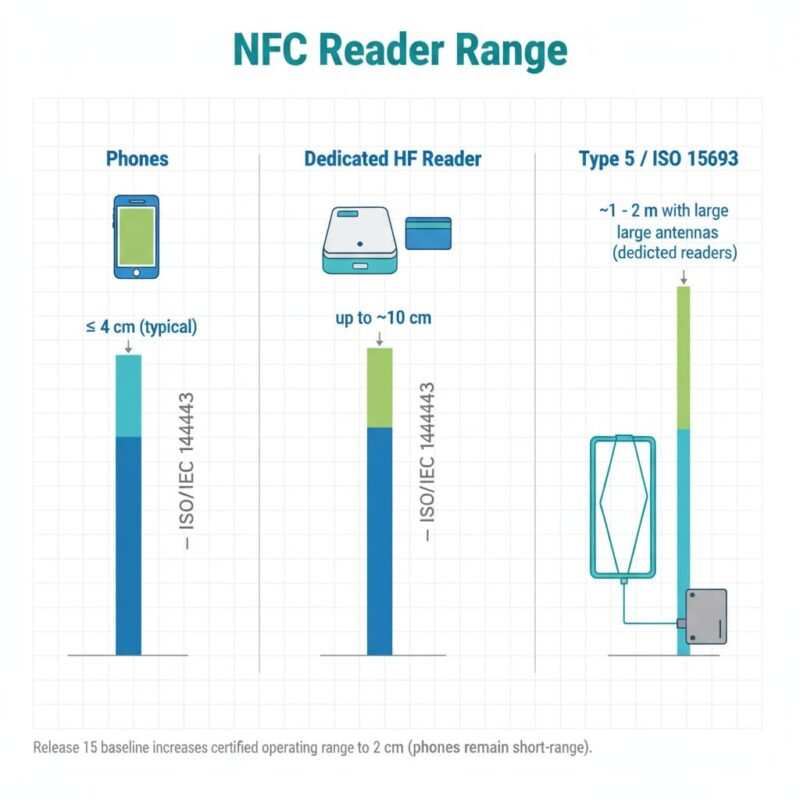
Smartphone Readers vs. Dedicated HF Readers
The NFC maximum distance you can achieve is defined by the reader.
- Smartphone Readers: These are designed for convenience, portability, and battery efficiency. Their antennas are small and power output is low, so the range will almost always be under 5-6 cm. They are perfect for user-initiated “tap” actions.
- Dedicated HF Readers: A powerful, dedicated High-Frequency (HF) reader, often built around a transceiver IC like the Texas Instruments TRF7970A, can have a much better NFC reader range. The reading distance varies by standard: around a few centimeters up to ~10 cm for ISO/IEC 14443 with dedicated HF readers; ISO/IEC 15693 (NFC Type 5/NFC-V) with large antennas and reader power can reach ~1–2 m (Source: STMicroelectronics).
The Future of NFC Range: The 2025 Update (NFC Release 15)
The NFC Forum is constantly working to improve the technology. The upcoming Release 15 specification, announced June 17, 2025, increases the certified operating range baseline from ~5 mm to up to 20 mm (2 cm). This will allow device makers to use smaller antennas while maintaining a reliable connection. Certification Release 15 is expected in Fall 2025, with gradual market adoption to follow (Learn More: NFC Forum Blog).
Getting the maximum range isn’t just about power; it’s also about precision. The physical alignment of the devices plays a surprisingly critical role in connection quality.
NFC Angles, Orientation, and “Radius” Explained
NFC works by using two coiled loop antennas that create a magnetic field to communicate. For the best connection, these two loops need to be aligned as closely as possible, both in position and angle. It’s less a perfect circle and more of an effective “operating volume.” The term NFC radius is a bit of a misnomer; think of it as a small, donut-shaped field where the connection is strongest.
NFC Forum specs define an operating volume, not a fixed ‘radius.’
Finding the “Sweet Spot”
The connection is strongest when the centers of the two antenna coils are lined up. If you tilt or twist one, the connection gets weaker. The NFC angles and orientation of your tap matter.
The NFC antenna on most phones is on the back, usually near the top or center around the camera module. To find your phone’s “sweet spot,” take an NFC tag and slowly move it across the back of your phone until it reads consistently. This is the spot you should aim for when tapping.
Proper alignment ensures a strong signal, but external factors can easily disrupt it. Let’s look at the common culprits that can interfere with an NFC connection.
What Interferes with NFC? Metals, Water, Cases, and Crowded RF
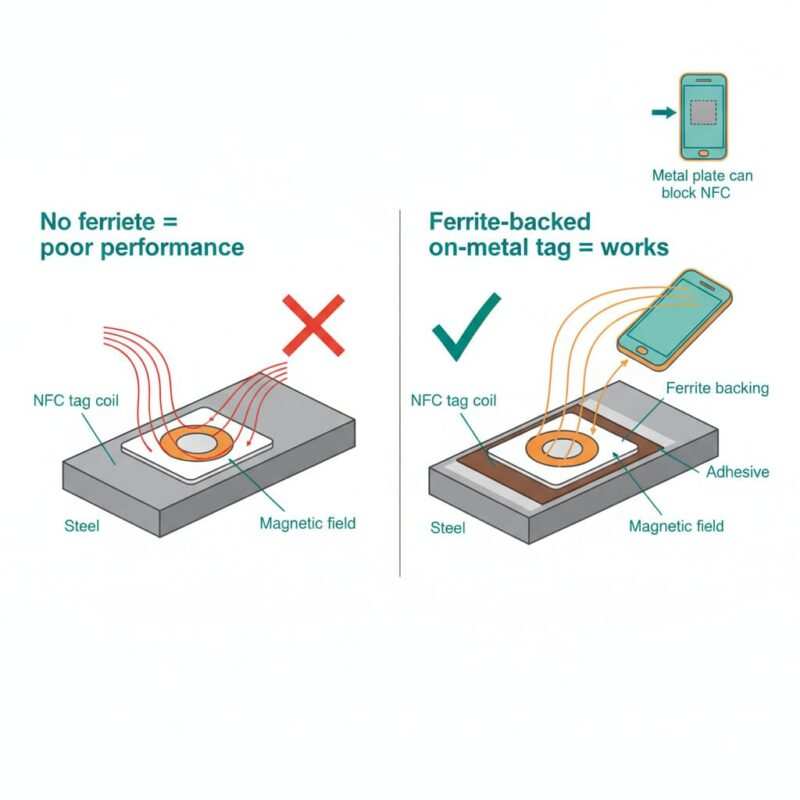
If you’ve ever asked, “what interferes with NFC?“, the answer is usually physical materials. As confirmed by vendor documentation for ISO/IEC 15693, NFC does not require an optical NFC line of sight to work, as the magnetic field can pass through materials like plastic or wood (Source: NXP ICODE). However, some materials are definite signal blockers.
The Metal Problem: How Ferrite Shielding Works
Metal is the arch-nemesis of NFC. The performance of an NFC near metal surface will be severely degraded or fail completely. Placing a standard tag on metal detunes its antenna and absorbs the energy from the reader. To fix this, you must use special “on-metal” tags, which have a thin layer of ferrite backing. Ferrite layers in ‘on‑metal’ tags redirect the magnetic field so tags can function on conductive surfaces (Source: Avery Dennison).
Choosing the Right Phone Case
Some phone cases can block or weaken your phone’s NFC signal.
- Good: Thin plastic (TPU), silicone, or leather cases usually cause no issues.
- Bad: Avoid cases with metal plates (often used for magnetic car mounts), thick battery packs, or carbon fiber layers, as these can block the signal. If you’re having trouble, try tapping with your case off to see if it’s the problem.
Understanding interference is key to troubleshooting, but it’s also helpful to see where NFC fits within the broader family of radio-frequency technologies.
NFC vs RFID: Range and Cost
It’s a common point of confusion: isn’t NFC just a type of RFID? Yes, it is. The debate of NFC vs RFID often comes down to specific use cases. NFC is a specific, high-frequency subset of RFID, but the two terms are used to describe very different applications.
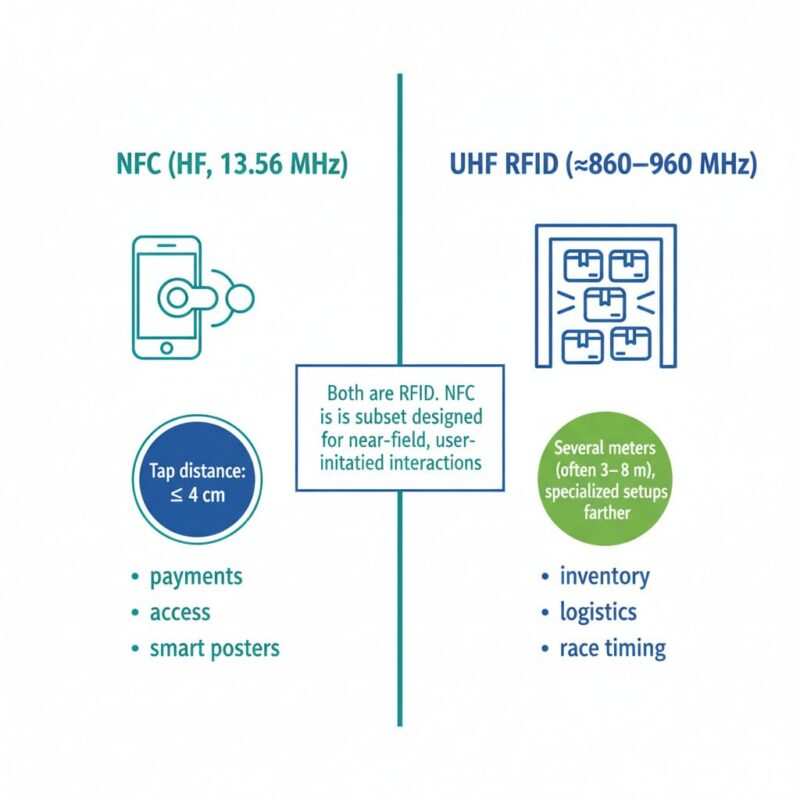
A Deeper Look: HF, LF, and UHF RFID
To understand the difference, it helps to know the main families of RFID:
- LF (Low Frequency): Very short range, excellent for use near metal or liquids. Used in animal tracking microchips and car key fobs.
- HF (High Frequency): This is the family NFC belongs to. Short range, used for access cards, library books, and NFC payments.
- UHF (Ultra-High Frequency): Long range, designed for reading many tags at once from a distance. The dominant standard here is UHF RFID (EPC Gen2). Passive UHF (RAIN) typically reaches several meters; active RFID can be hundreds of meters (Source: RFID Journal).
Which is more expensive: NFC or RFID?
When considering NFC vs RFID cost, passive UHF tags are often cheaper in bulk (pennies per tag), but require expensive readers. NFC tags may cost slightly more per unit, but the reader is already in everyone’s pocket: their smartphone. According to industry sources like RFID Journal, the crucial trade-off is smartphone compatibility vs. supply-chain range.
| Use Case | Recommended Technology | Why? |
|---|---|---|
| Mobile payments, smart posters, networking | NFC | Uses the smartphone as a reader; designed for user interaction. |
| Warehouse inventory, race timing, logistics | UHF RFID | Needs long-range, bulk reading with a specialized reader. |
Now that you know how to choose the right technology, let’s focus on maximizing the performance of your NFC tags for the most reliable results.
How to Increase NFC Range
While you can’t turn your phone into a long-range scanner, you can take practical steps to get the most reliable connection possible. Learning how to increase NFC range comes down to a few key physical adjustments.
Practical Steps for Better Performance
- Choose the Largest Tag Possible: Within the constraints of your project, a larger antenna provides a bigger target for the reader, improving performance. A long-range NFC tag is often a Type 5 tag with a large antenna paired with the right reader.
- Always Use On-Metal Tags Near Metal: Don’t skip the ferrite layer. It’s not optional; it’s essential for the tag to work on a metal surface.
- Test for the Sweet Spot: Know where your phone’s NFC antenna is and aim for good alignment with the tag’s antenna.
- Remove Obstructions: Take off any thick or metallic phone cases that could be blocking the signal.
Advanced Methods (For Developers)
For those building custom hardware, a couple of advanced techniques can help maximize range and reliability:
- Precise Antenna Tuning: Use specialized equipment to tune an antenna for optimal performance in its final environment.
- External Antenna Cabling: If you must route to a remote antenna, use 50‑ohm coax, keep it short, and include matching on both sides of the cable; then retune the full path. This ensures that any added NFC antenna cable length doesn’t cause significant signal loss (Source: NXP Community Forum).
Beyond just range, the type of tag you choose determines what you can do with it. Let’s break down the different tag types and their capabilities.
NFC Tag Types, Memory, and “Read‑Only” Options
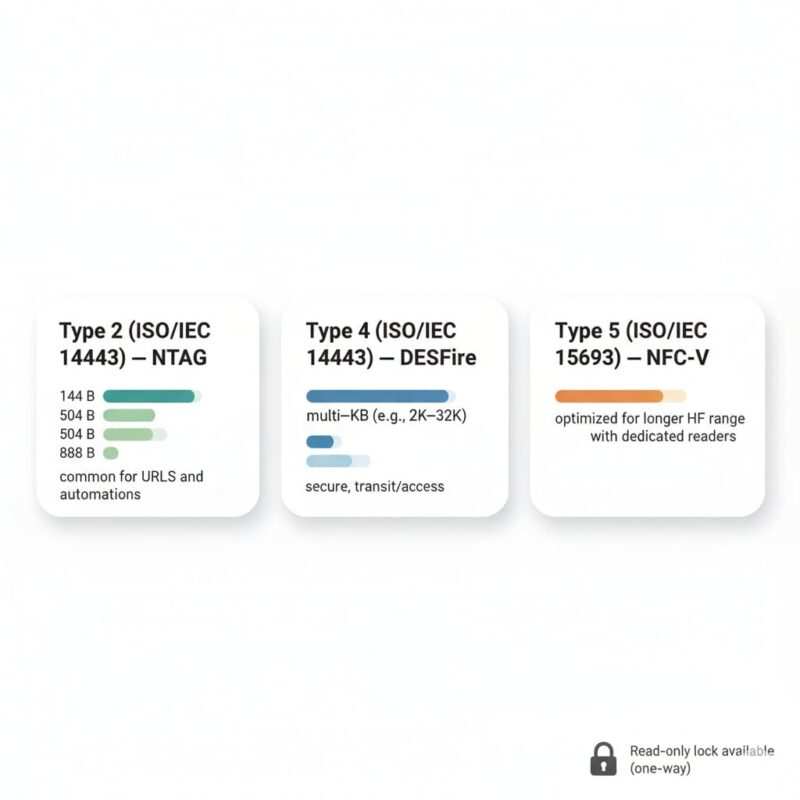
Not all NFC tags are created equal. They vary by memory, features, and the standards they follow.
A Guide to Common NFC Tag Types
- Type 2: The most common and affordable type, based on ISO/IEC 14443. Used widely in marketing and smart posters. NXP’s NTAG series are popular Type 2 tags.
- Type 4: More secure and flexible, with more memory, also based on ISO/IEC 14443. Often used for transit passes or payment cards where security is critical, such as NXP’s MIFARE DESFire product line.
- Type 5: The long-range specialist. This is the NFC Forum Type 5 tag (also known as NFC-V), based on the ISO/IEC 15693 standard. It’s designed for applications like library management or ticketing. Tag families like STMicroelectronics’ ST25 series fall into this category. The NFC Type 5 range is the best you can get in the NFC family.
How Much Memory Do You Really Need?
Most common tags have a small amount of NFC memory size. This is usually more than enough. Based on chip datasheets, here are some specifics:
- NXP NTAG213/215/216: These popular tags provide 144/504/888 bytes of user memory, 10-year retention, and ~100k write cycles (Source: NXP NTAG Datasheet). To learn more, see this comparison of NTAG213 vs 215 vs 216.
- NXP MIFARE DESFire EV2/EV3: These secure cards are typically available in 2K, 4K, 8K (and higher) options (Source: NXP DESFire EV2).
While higher capacity tags exist, a 1MB NFC tag is not a standard, mainstream product class. For context:
- A web link (URL): ~20-50 bytes
- A full digital business card (vCard): ~200-600 bytes. This is a popular use case; you can learn more about how NFC business cards work and compare NFC vs QR codes for business cards.
Why and How to Lock Your NFC Tag
For security, most NFC tags can be permanently locked to become a read-only NFC tag. This is a one-way action that prevents anyone from changing the data on the tag. It’s highly recommended for any tags placed in public, such as on a product or poster. Most NFC apps, like NFC Tools, have a simple function to lock your tag after you’ve written your data to it.
With a solid understanding of the hardware, you’re ready to explore the frequently asked questions that come up when working with NFC technology.
FAQ on NFC Range
What frequency do NFC tags use?
All NFC tags and readers use the NFC frequency 13.56 MHz (HF).
How far do NFC tags work?
For smartphones, the practical range is under 4 cm (about 1.5 inches). The connection is intentionally short for security. With specialized readers, some NFC tags can work from over a meter away.
What is the radius of NFC?
NFC doesn’t have a fixed ‘radius’; specs define an operating volume that depends on antenna size, alignment, and environment.
Is NFC’s maximum range 10 cm?
For ISO/IEC 14443 based tags, ~10 cm is a practical upper bound with dedicated readers; phones are usually ≤4 cm. Release 15’s 2 cm baseline improves reliability, not long‑range operation.
Do NFC tags ever stop working?
Yes. NFC tags have a limited lifespan based on data retention (usually around 10 years) and the number of times they can be written to (often 100,000 cycles). Physical damage can also break the tag.
How far away can NFC be read?
For phones, the practical range is typically under 4 cm (1.5 inches). With specialized equipment, certain types of NFC tags can be read from over a meter away.
Does NFC need line of sight?
No. NFC uses a magnetic field, not light, so it does not require a direct NFC line of sight. However, physical barriers like metal can block the field.
Can NFC work through clothes?
Yes, NFC can usually work through thin fabrics like a shirt or pants pocket, as cloth does not block the magnetic field. However, the short range still applies.
How to tell NFC vs RFID?
If you can read it with a standard smartphone, it’s NFC. If it’s used for tracking inventory from many feet away with a dedicated scanner, it’s likely UHF RFID.
What is the range of NFC Type 5?
The NFC Type 5 range, based on the ISO/IEC 15693 standard, is the longest among NFC types. With proper HF readers and large antennas, it can achieve a range on the order of 1–2 meters. However, when read by a phone, the range is still short.
What’s the longest range for an RFID reader?
Passive UHF RFID readers typically have a range of several meters (often 3–8 m), and much farther with specialized antennas. Active RFID systems, where the tag has its own battery, can reach hundreds of meters.
What is the length of an NFC antenna cable?
There is no standard length. For custom-built readers, the NFC antenna cable should be kept as short as possible and impedance-matched (usually to 50 ohms) to prevent signal loss.
Conclusion: Range Is a Feature, Not a Flaw
Ultimately, the answer to “how far can an NFC card be read?” is “not very far, by design.” The short range of NFC is its greatest asset, providing a layer of security and user intent that long-range technologies lack. While it’s possible to achieve a greater reading distance with specialized hardware like NFC Type 5 tags and dedicated readers, the everyday experience with a smartphone will always be a close-range tap.
By understanding the key factors—tag size, antenna alignment, and environmental interference—you can ensure your NFC interactions are reliable and effective. Whether for payments, smart business cards, or marketing, NFC’s strength lies in its simplicity and the deliberate, secure connection it creates.
How We Researched and Tested: To find the real-world range of NFC, we used a modern smartphone to test several common NFC tags, from tiny stickers on metal surfaces (with ferrite backing) to standard-sized labels on a wooden desk. This article combines our hands-on findings with technical specifications from authoritative sources like the NFC Forum and major chip manufacturers like NXP.
Meet Oladepo Babatunde, a technical writer and researcher who makes digital business cards easy to use in the real world. As the founder of CardAdviceHub.com, Oladepo turns tap‑to‑connect tech into clear, reliable workflows—covering NFC/QR setup, troubleshooting, platform comparisons, and practical design tips. He draws on a Higher National Diploma in Computer Science and more than a decade of writing experience since 2014 to test cards, apps, and accessories hands‑on, then share step‑by‑step guides with screenshots, checklists, and templates you can follow in minutes. When he’s not filming tutorials, he’s building resources that help solo creators and teams launch faster—no code required. CardAdviceHub focuses on informational how‑tos and does not publish financial advice.
Areas of focus: NFC tags and chips (NTAG213/215/216), iPhone/Android setup, QR best practices, platform integrations (Sheets, HubSpot, Zapier), event signage and accessories.
How I test: Real devices, repeated tap/read tests with different cases/materials, screenshots and videos for every step, and “first‑try” reliability checks.
Editorial standards: Every how‑to is reproducible, updated when apps change, and clearly labels any affiliate relationships. No financial advice.
Contact: info@cardadvicehub.com (or contact us)
